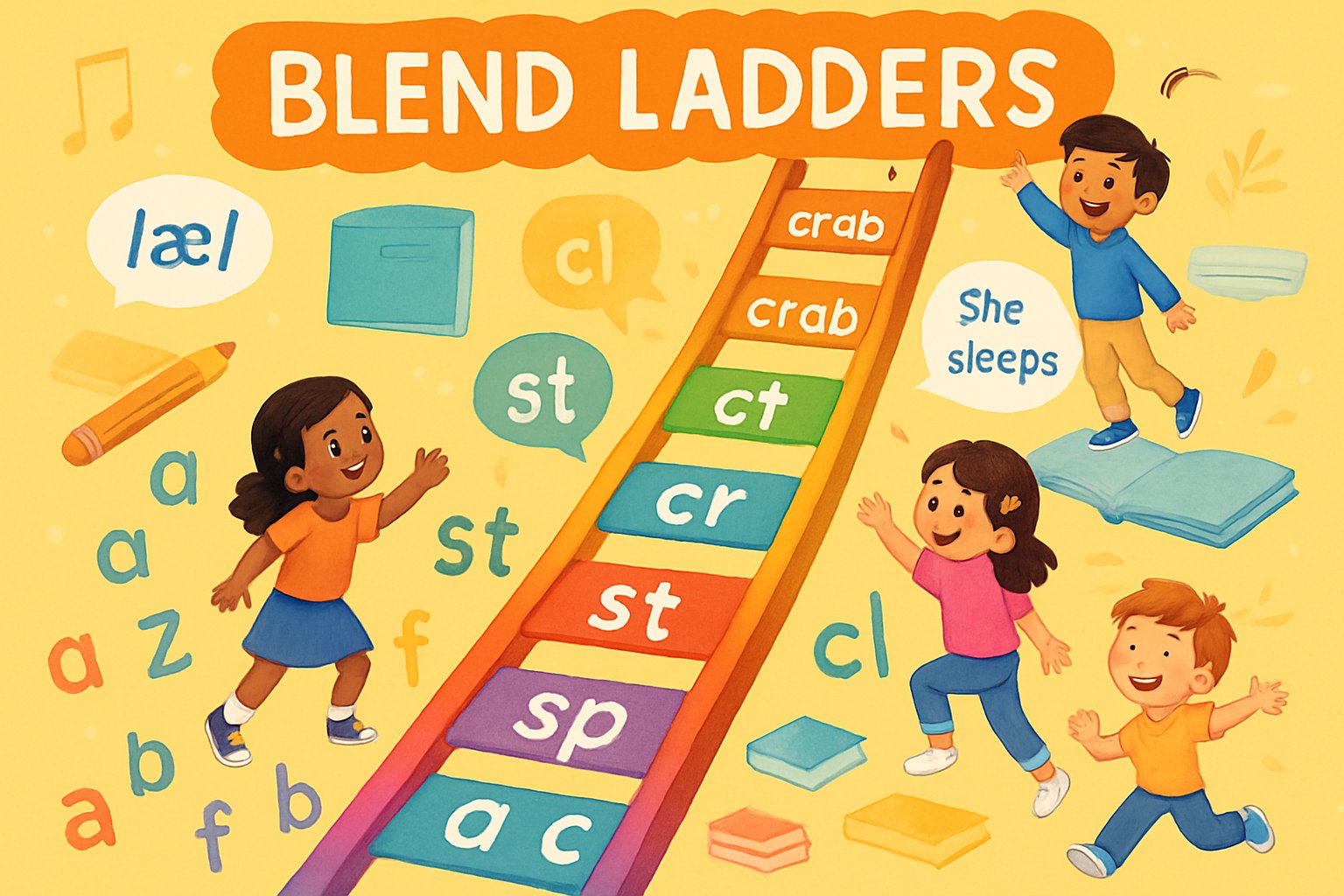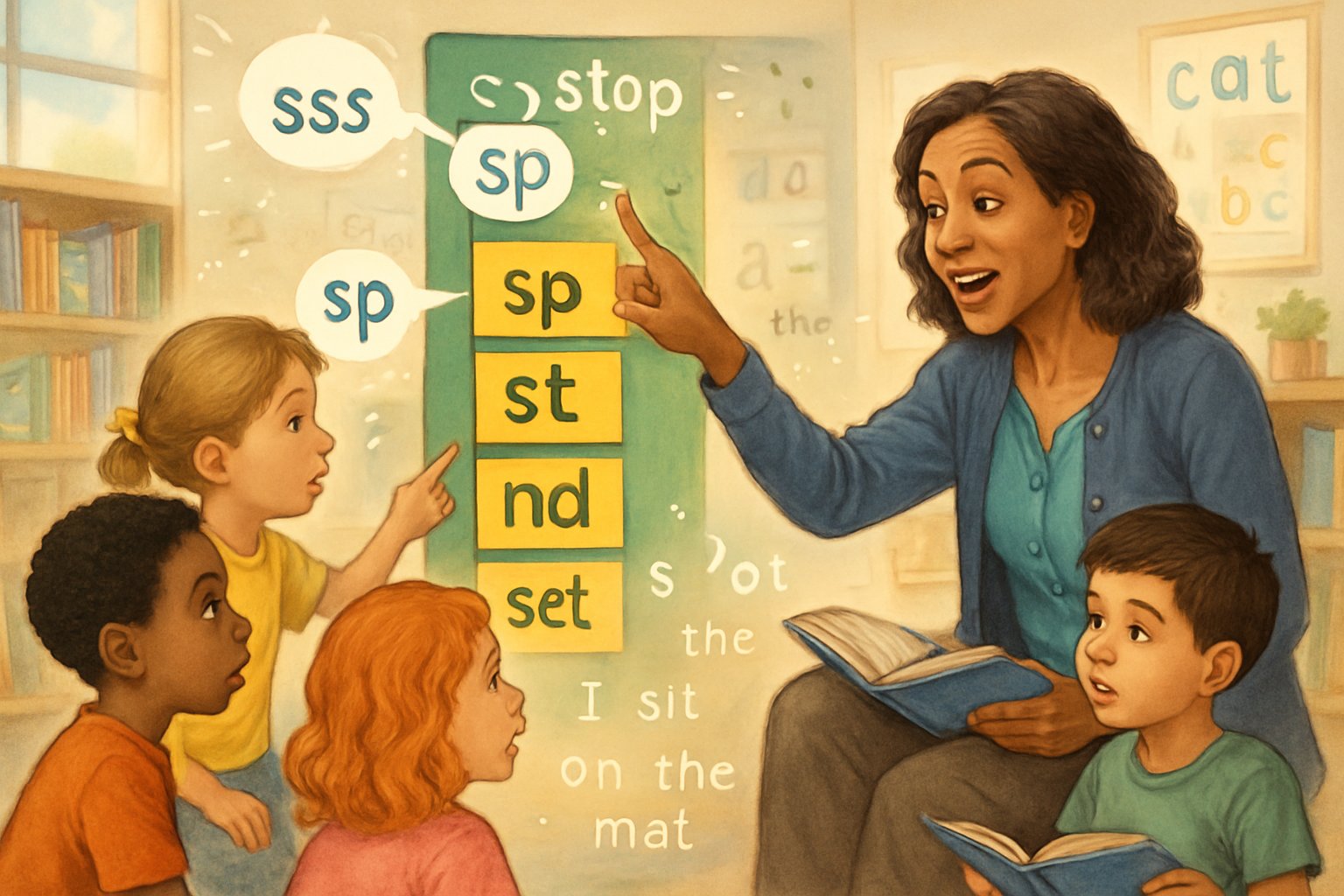How Blend Ladders Accelerate Early Literacy Skills

Blend ladders help children connect spoken and written language by strengthening how they hear, see, and combine sounds. They build confidence in decoding and spelling by turning phonemic awareness into hands-on practice that supports lasting reading growth.
What Are Blend Ladders?
Blend ladders are structured reading tools that guide students through small sound changes to form new words. Each “rung” of the ladder changes one letter or sound, such as moving from cat → bat → bit. This step-by-step process supports clear letter-sound correspondence and helps students see patterns in how words are built.
Teachers use blend ladders to teach phonics skills in a visual and interactive way. Students often point to or write each word as they sound it out, reinforcing both auditory and visual memory.
blend ladders improve decoding and recognition by giving repeated practice with familiar word families. They make abstract sound manipulation concrete and easy for young readers to grasp.
The Science Behind Blending Sounds
Reading research shows that phonemic awareness—the ability to hear and blend individual sounds—is a strong predictor of reading success. Blend ladders target this skill by having students isolate, substitute, and combine sounds in a controlled sequence.
When children practice blending /c/ /a/ /t/ into cat, they develop the foundation for fluent reading. The structured repetition strengthens neural pathways that connect sounds to letters.
Activities like those described by Understood.org show that systematic blending practice supports accurate decoding. Students learn to apply these skills to new words, which builds confidence and fluency.
Teachers can track progress by noting how quickly and accurately students blend sounds. This data helps identify which phonics patterns need more review or support.
Blend Ladders vs. Traditional Phonics Activities
Traditional phonics lessons often focus on memorizing letter-sound rules or reading word lists. Blend ladders take a more interactive and scaffolded approach, encouraging students to manipulate one sound at a time.
This focused change keeps cognitive load low while still building complexity. For example, a student might move from pan → pen → pen → pet, reinforcing vowel and consonant shifts.
In contrast to worksheets, blend ladders engage multiple senses—seeing, saying, and writing—which improves retention. Exceed in Learning explains that this multisensory method helps children internalize sound patterns faster than rote repetition.
Teachers find that blend ladders fit easily into small-group instruction or literacy centers. Their flexibility allows for differentiation, supporting both emerging and advanced readers.
Practical Strategies for Using Blend Ladders in Reading Instruction

Effective use of blend ladders helps students connect sounds to letters, strengthen decoding, and gain fluency with common word patterns. Teachers can adapt these tools to match student levels, moving from simple CVC words to more complex blends and digraphs while keeping practice focused and engaging.
Building CVC Words and Short Vowel Mastery
Students begin with CVC words (consonant-vowel-consonant) to build a strong foundation in short vowel sounds. Starting with words like cat, bat, and bag helps them focus on one sound change at a time.
Teachers can use a simple ladder format:
| Step | Word | Focus Sound |
|---|---|---|
| 1 | cat | /a/ |
| 2 | bat | /b/ |
| 3 | bag | /g/ |
This pattern shows how changing one letter alters the sound. Repeated practice builds automatic recognition of vowel patterns.
Students should say each sound aloud, blend them smoothly, and write the word. This multisensory approach strengthens both reading and spelling. Using short sessions of 10–15 minutes keeps attention high and encourages consistent progress.
Integrating Consonant Blends and Digraphs
Once students master short vowels, teachers can add consonant blends like bl, st, and tr, along with digraphs such as ch and sh. These patterns help students decode longer words accurately.
Blend ladders that focus on blends might include examples like flag → flat → flit → flip. For digraphs, teachers can use ship → chip → chap → chat.
Students should listen carefully to hear how the beginning or ending blend changes each word. Teachers can model continuous blending to connect sounds smoothly, as suggested in this guide on teaching blending.
Visual aids, such as color-coded letters for blends and digraphs, help students recognize patterns faster. Gradual introduction of new blends keeps lessons manageable and reduces confusion.
Step-by-Step Decoding with Blend Ladder Printables
Printable ladders provide structured, hands-on practice. Many educators use blend ladder printables to guide students through sound changes while offering visual support.
Students start by reading each word down the ladder, blending sounds aloud. Next, they write each word and underline the letter that changes. This step-by-step decoding process helps them see and hear the link between letters and sounds.
Using both real and nonsense words like lat, lit, lot, and lut strengthens decoding skills by encouraging attention to phonics rather than memorization. Teachers can track progress by noting how quickly and accurately students complete each ladder.
Incorporating Blend Ladders in Literacy Centers
Literacy centers give students a chance to practice blend ladders independently or in small groups. Each station can focus on a specific pattern, such as short vowels, blends, or digraphs.
Teachers can rotate activities weekly to maintain interest. For example:
- Center 1: Build CVC ladders with letter tiles
- Center 2: Match pictures to blend ladder words
- Center 3: Use digital ladders for timed decoding practice
According to Clever Homeschool’s overview of blend ladders, short, focused sessions help struggling readers gain confidence without feeling overwhelmed.
By combining movement, sound, and visual cues, literacy centers make decoding practice interactive and effective for all learners.
Expanding Skills: Word Families, Spelling, and Free Resources

Children strengthen their reading and writing when they connect sounds, patterns, and letters in meaningful ways. Activities like word families, spelling ladders, and printable resources give them hands-on practice that builds fluency and confidence.
Using Word Families to Enhance Blending
Word families group words that share the same ending pattern, such as -at, -ig, or -op. This helps children recognize common spelling patterns and predict how new words sound. They begin to see that cat, bat, and hat all share a similar structure.
Working with word families supports phonemic awareness and decoding. Students learn to blend beginning sounds with familiar endings, which improves reading fluency. According to Education.com, this pattern-based approach helps children decode new words more easily and strengthens early spelling skills.
Teachers can use short lists, flashcards, or sorting games. For example:
| Word Family | Example Words |
|---|---|
| -at | cat, hat, mat |
| -in | pin, fin, win |
| -ug | bug, rug, hug |
These small sets make practice focused and manageable.
Developing Spelling Skills Through Ladders
Word ladders, also known as blend ladders, help children analyze how small letter changes create new words. Students start with one word and change one letter at a time. For example, cat → cot → dot → dog.
This method builds both decoding and encoding skills. As described by Literacy Learn, students listen for sounds, identify which letter changes, and write the new word. This connects phonemic awareness with written spelling.
Teachers can guide students by dictating each new word and encouraging them to say the sounds aloud. Repeating this process daily helps learners recognize spelling patterns and understand how sounds map to letters. Over time, their accuracy and confidence grow naturally.
Accessing and Using Free Blend Ladder Printables
Printable blend ladders make it easy to bring structured phonics practice into classrooms or homes. Sites like Literacy Learn and Storytime Standouts offer free materials that include CVC word lists and sound boxes.
Teachers can print these ladders, laminate them, and reuse them for small group lessons. Students fill in each rung as they change one sound at a time.
To make practice more interactive, children can:
- Use letter tiles or magnets to build each word.
- Read the ladder aloud from bottom to top.
- Highlight vowel changes in different colors.
Free blend ladders save preparation time and provide consistent, structured phonics practice that supports early literacy growth.
Leave a Reply